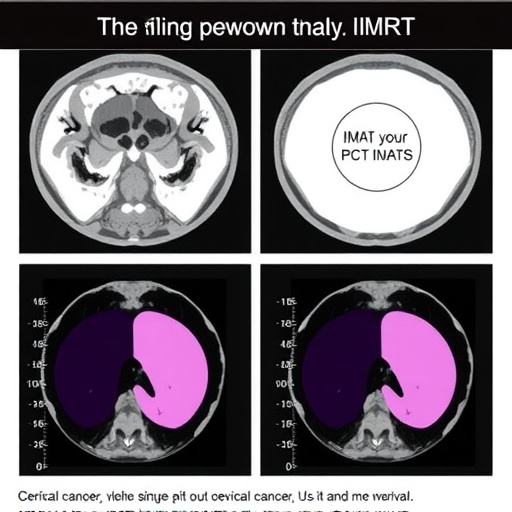In a landmark study published in BioMedical Engineering OnLine, researchers have provided new insights into the comparative effects of two advanced radiotherapy techniques, intensity-modulated radiotherapy (IMRT) and volumetric modulated arc therapy (VMAT), in the treatment of cervical cancer. This investigation sheds light on survival benefits, adverse effects, and poor prognostic factors, potentially influencing future therapeutic choices and clinical protocols for this prevalent gynecologic malignancy.
Cervical cancer remains a significant global health challenge, with radiotherapy being a cornerstone in its management. Both IMRT and VMAT have emerged as precision treatment modalities designed to maximize tumor control while minimizing damage to surrounding healthy tissues. However, nuances in their clinical outcomes and side effect profiles have remained underexplored, prompting this comprehensive retrospective analysis of 186 patients treated at a leading hospital from January 2022 to December 2023.
IMRT, characterized by its ability to modulate radiation intensity within multiple beams, has been extensively used to deliver conformal doses to cervical tumors. Conversely, VMAT, a more recent innovation, leverages dynamic arc therapy by continuously adjusting radiation dose rates and beam shapes as the machine rotates around the patient. This dynamic mechanism aims to enhance dose conformity and treatment speed, potentially reducing toxicity.
.adsslot_SMvzN6FxJB{width:728px !important;height:90px !important;}
@media(max-width:1199px){ .adsslot_SMvzN6FxJB{width:468px !important;height:60px !important;}
}
@media(max-width:767px){ .adsslot_SMvzN6FxJB{width:320px !important;height:50px !important;}
}
ADVERTISEMENT
The study divided patients into two cohorts: 126 individuals receiving static IMRT combined with cisplatin chemotherapy, and 60 patients treated with VMAT alongside cisplatin. This dual-modality approach highlights the current standard, as cisplatin acts as a radiosensitizer, augmenting the efficacy of radiation treatments.
Upon rigorous comparison, no statistically significant difference emerged between the two groups in terms of disease control rate (DCR), objective remission rate (ORR), overall survival, or recurrence rates. This suggests that both IMRT and VMAT offer comparable effectiveness in short-term tumor management and control when combined with chemotherapy in cervical cancer patients.
Despite these similarities in therapeutic outcomes, the toxicity profiles illuminated a noteworthy divergence. Patients undergoing IMRT experienced a markedly higher incidence of myelosuppression—an adverse effect characterized by the suppression of bone marrow activity leading to decreased blood cell production. This differential toxicity may influence patient quality of life and the feasibility of completing prescribed treatment regimens.
To further elucidate factors contributing to patient prognosis, the researchers employed Cox multivariate regression analysis, a statistical technique adept at identifying independent variables influencing survival outcomes. The analysis demonstrated that lymph node metastasis (LNM) and positive surgical margins after tumor resection significantly correlated with poorer prognosis post-radiotherapy.
LNM indicates the extent of cancer dissemination beyond the primary tumor site, often heralding a more aggressive disease course. Positive surgical margins, where cancerous cells remain at the edges of excised tissues, suggest incomplete tumor removal and a higher likelihood of residual disease leading to recurrence.
By pinpointing these two parameters as independent risk factors, the study underscores the critical importance of surgical thoroughness and accurate staging in cervical cancer management. Moreover, these findings advocate for integrating aggressive monitoring and tailored therapeutic strategies for patients exhibiting these risk determinants.
Technically, VMAT’s advantage is rooted in its ability to deliver radiation dose more efficiently and conformally through simultaneous modulation of gantry speed, dose rate, and multi-leaf collimator positioning. This dynamic delivery optimizes radiation targeting, minimizes dose spill to surrounding normal tissues, and shortens treatment times compared to IMRT’s static beam arrangements.
However, the study’s retrospective design calls for prospective trials to validate these results and explore long-term outcomes beyond the short-term follow-up period analyzed. Additionally, investigating how these radiotherapy modalities interact with emerging systemic therapies and immunomodulators could pave the way for enhancing cervical cancer treatment paradigms.
This research enriches the oncologic community’s understanding of radiotherapy modalities in cervical cancer by meticulously examining efficacy, adverse effects, and prognostic indicators. It sets the stage for personalized radiotherapy approaches, balancing tumor control, toxicity, and prognostic variables to optimize patient survival and quality of life.
As global efforts persist to curb the burden of cervical cancer, integrating evidence-based refinements in radiotherapy will be vital. The insights from this study prompt reassessment of clinical protocols and encourage the adoption of VMAT where feasible, especially in patients at risk for treatment-related hematologic toxicity.
In summary, both IMRT and VMAT maintain their positions as effective therapeutic modalities against cervical cancer, demonstrating similar control rates and survival outcomes. The differential toxicity profile favoring VMAT and the identification of lymph node metastases and surgical margin positivity as key adverse prognostic markers offer critical guidance for clinicians navigating treatment decisions in this complex disease landscape.
Subject of Research:
The study investigates the comparative impact of intensity-modulated radiotherapy (IMRT) and volumetric modulated arc therapy (VMAT) on survival benefits, adverse reactions, and prognostic factors in patients with cervical cancer.
Article Title:
Effects of intensity-modulated radiotherapy (IMRT) and volumetric modulated arc therapy (VMAT) on survival benefits and poor prognostic factors in patients with cervical cancer
Article References:
Li, M., Wu, X., Liu, X. et al. Effects of intensity-modulated radiotherapy (IMRT) and volumetric modulated arc therapy (VMAT) on survival benefits and poor prognostic factors in patients with cervical cancer. BioMed Eng OnLine 24, 96 (2025). https://doi.org/10.1186/s12938-025-01433-1
Image Credits: AI Generated
DOI:
https://doi.org/10.1186/s12938-025-01433-1
Tags: adverse effects of radiotherapycervical cancer survival ratesdynamic arc therapy for cancergynecologic malignancy treatment optionsIMRT vs. VMAT cervical cancerintensity-modulated radiotherapy benefitsprecision treatment modalitiesprognostic factors in cervical cancerradiotherapy techniques comparisonreducing toxicity in cancer treatmentretrospective analysis of cancer treatmentsvolumetric modulated arc therapy advantages





